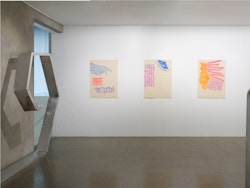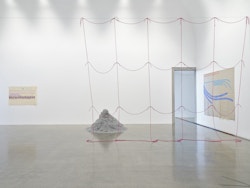Giorgio Griffa
Giorgio Griffa and Peter Robinson: Differences in kind and rhythm
8 June—24 August 2025
Te Uru Gallery, Auckland, New Zealand
Differences in kind and rhythm is the second in a series of dialogue exhibitions made at Te Uru since 2024 for which artists from Aotearoa are paired with international artists. This dialogue pairs the practices of Italian abstract painter Giorgio Griffa (b.1936, Turin) and local sculptor Peter Robinson (Ngāi Tahu, b.1966, Hakatere). Despite being artists of different generations, backgrounds, and contexts, Griffa and Robinson similarly use repeat forms and processes in their work to address related concepts of repetition and difference, emergence and continuum. The conversation between works in this exhibition is concerned equally with these similar approaches to practice and their underlying distinctions, forming a cross-cultural exchange between Māori and Western worldviews.

Together, the paintings by Griffa and sculptures by Robinson in Differences and kind and rhythm span a period from 1972 to 2025. What they share in common primarily are sequences of repeat processes and forms. Through repetitive gestures such as line making, stacking, and folding, the artists create sequential or modular compositions that visually map their own becoming. As we trace these sequences, we are looped into a process of emergence. These ‘mappings’ also illustrate subtle distinctions between similar forms—such as variations in thickness, colour, shape, transparency, tightness, angle, or position—suggesting that over time, even repeat processes lead to change. Here, we are invited to consider if any two similar things or events can be deemed identical and how subtle differences shape our experience of the evolution of ideas, things, and even ourselves. Each addition to a sequence changes the very sequence it occupies—a process of repetition towards difference. Across exhibited works we find patterns of basic singular forms (lines, dashes, numerals) and sequent buildups of objects (such as lengths of wire, aluminium cubes, or die-cut felt pieces). Although we encounter them as fixed compositions on canvas or in space, they compel us to imagine how their sequences might change, holding us in what feels like a temporary or dormant state between the past (the material traces we see) and future (their pending evolution). These sequences operate like emergent systems—networks in which individual components are understood and informed by their grouping or collaboration. This gives the paintings and sculptures a sense of animation, evolution, or even sociality. What we perceive as near-automatic systems of composition are in fact open-ended processes alive with possibilities for variation and potentially endless unfolding.

Held across three rooms, Differences in kind and rhythm proceeds from simpler, sparer uses of lines by Griffa and Robinson to more complex, lyrical, and colourful networks in their paintings and sculptures and, finally, onto their most recent sequencings of numbers and spiral forms with overt reference points. The signs, shapes, and numbers we see in works by Griffa and Robinson draw on ranging subjects found in mathematics, nature, and philosophy, including the golden ratio and koru, binary code, cosmology, and time, and the indeterminate space between something and nothing. The exhibition also operates along the slippery line between painting and sculpture, with only paintings by Griffa and only sculptures by Robinson, forming an installation in which two and three-dimensional compositions interact, animating the shared space between them. Pinned to the wall with obvious creases, Griffa’s unstretched paintings feel sculptural, while, conversely, Robinson’s lineal sculptures read like drawings in space.
